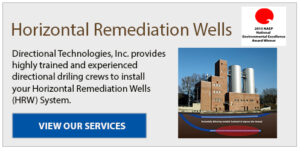Are you considering a horizontal remediation system for your project? As you decide, here are some things to consider and site data necessary to help you make the right choice.
 So your remediation project is moving towards a choice of remedy. You’ve read the case studies, been to the conferences, and the concept of Horizontal Remediation Wells (HRW’s) for your site seems intriguing. Whether it involves dual phase extraction, total phase extraction, biosparging, Soil vapor extraction (SVE), Air sparge/SVE, biosparge, chemox delivery, or any combination of them, a horizontal remediation system could be the solution.
So your remediation project is moving towards a choice of remedy. You’ve read the case studies, been to the conferences, and the concept of Horizontal Remediation Wells (HRW’s) for your site seems intriguing. Whether it involves dual phase extraction, total phase extraction, biosparging, Soil vapor extraction (SVE), Air sparge/SVE, biosparge, chemox delivery, or any combination of them, a horizontal remediation system could be the solution.
So, what should consider before proposing a horizontal remediation system for your site?
Utilizing Horizontal Remediation Wells for the application of any of the remediation techniques has the benefits of providing enhanced coverage within, above, or below the body of the contaminant plume.
Horizontal wells have more contact with the contaminated zone(s) and bisect the zone to provide enhanced influence to the area requiring treatment.
Horizontal Wells follow the lateral plane of the contaminant zone, rather than simply piercing the smear zone numerous times.
Other factors to consider in making the horizontal remediation system choice are the lack of site disruption, especially in operating facilities, and simplification of above-ground treatment systems due to the limitation of multiple remediation wells.
The most important data necessary to make an intelligent, cost effective decision to the applicability of Horizontal Remediation Wells on your site is gained through the performance of a scaled down remedial feasibility study for the site. Critical data to design the optimum system are not just limited to “High Resolution” drilling programs, but also the performance of pump tests, SVE tests, Air Sparging tests, etc. to determine critical design criteria for any remediation well network. Contaminant plume maps, drill logs and cross sections are also required for the optimum well design.
After review of this data, and extrapolation of necessary vertical well coverage over the site, determination of the costs for plumbing, electrical installation, power consumption, and O&M, the project team can then compare those costs with the costs of Horizontal Remediation Wells. The reduced costs of infrastructure and O&M often show remarkable cost savings by utilizing a horizontal remediation system. Also, the short duration of the remediation phase often achieved utilizing Horizontal Remediation Wells provides further overall project cost reductions.
Directional Technologies can provide insight to the best application of the horizontal technology for your site based on more than 3 decades of experience in the design, installation, operation and maintenance of horizontal remediation systems. By providing the above-mentioned remedial feasibility data to our specialists for review, we can determine the optimum horizontal well layout to achieve maximum performance for your remediation technique of choice.